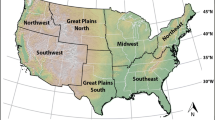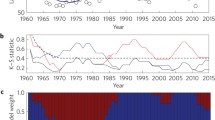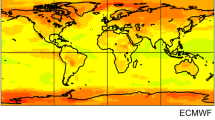Abstract
Predictability is an intrinsic limit of the climate system due to uncertainty in initial conditions and the chaotic nature of the atmosphere. Estimates of predictability together with calculations of current prediction skill are used to define the gaps in our prediction capabilities, inform future model developments, and indicate to stakeholders the potential for making forecasts that can inform their decisions. The true predictability of the climate system is not known and must be estimated, typically using a perfect model estimate from an ensemble prediction system. However, different prediction systems can give different estimates of predictability. Can we determine which estimate of predictability is most representative of the true predictability of the climate system? We test three metrics as potential indicators of the fidelity of predictability estimates in an idealized framework—the spread-error relationship, autocorrelation and skill. Using the North American multi-model ensemble re-forecast database, we quantify whether these metrics accurately indicate a model’s ability to properly estimate predictability. It is found that none of these metrics is a robust measure for determining whether a predictability estimate is realistic for El Nino-Southern oscillation events. For temperature and precipitation over land, errors in the spread-error ratio are related to errors in estimating predictability at the shortest lead-times, while skill is not related to predictability errors. The relationship between errors in the autocorrelation and errors in estimating predictability varies by lead-time and region.









Similar content being viewed by others
References
Barker TW (1991) The relationship between spread and forecast error in extended-range forecasts. J Clim 4(7):733–742
Barnston AG (2017) Deterministic skill of ENSO predictions from the North American multimodel ensemble. Clim Dyn. doi:10.1007/s00382-017-3603-3
Barnston AG, Tippett MK, L’Heureux ML, Li S, DeWitt DG (2012) Skill of real-time seasonal ENSO model predictions during 2002–11: is our capability increasing? Bull Am Meteorol Soc 93(5):631–651
Becker E, den Dool Hv, Zhang Q, (2014) Predictability and forecast skill in NMME. J Clim 27(15):5891–5906
Berner J, Jung T, Palmer TN (2012) Systematic model error: the impact of increased horizontal resolution versus improved stochastic and deterministic parameterizations. J Clim 25:4946–4962
Boer GJ (1984) A spectral analysis of predictability and error in an operational forecast system. Mon Weather Rev 112(6):1183–1197
Buizza R (1997) Potential forecast skill of ensemble prediction and spread and skill distributions of the ECMWF ensemble prediction system. Mon Weather Rev 125(1):99–119
Chen M, Kumar A (2014) Influence of ENSO SSTs on the spread of the probability density function for precipitation and land surface temperature. Clim Dyn 45:965–974
Chen M, Shi W, Xie P, Silva VBS, Kousky VE, Wayne Higgins R, Janowiak JE (2008) Assessing objective techniques for gauge-based analyses of global daily precipitation. J Geophys Res 113(D4):D04 (110–13)
Christensen HM, Moroz IM, Palmer TN (2014) Evaluation of ensemble forecast uncertainty using a new proper score: application to medium-range and seasonal forecasts. Q J R Meteorol Soc 141(687):538–549
Compo GP, Sardeshmukh PD (2004) Storm track predictability on seasonal and decadal scales. J Clim 17(19):3701–3720
Dalcher A, Kalnay E (1987) Error growth and predictability in operational ECMWF forecasts. Tellus A 39A(5):474–491
Delworth TL, Broccoli AJ, Rosati A (2006) GFDL’s CM2 global coupled climate models. Part I: formulation and simulation characteristics. J Clim 19(5):643–674
DeWitt DG (2005) Diagnosis of the tropical Atlantic near-equatorial SST bias in a directly coupled atmosphere–ocean general circulation model. Geophys Res Lett 32(L01):703
Doblas Reyes FJ, Déqué M, Piedelievre JP (2000) Multi-model spread and probabilistic seasonal forecasts in PROVOST. Q J R Meteorol Soc 126(567):2069–2087
Eade R, Smith D, Scaife A, Wallace E (2014) Do seasonal-to-decadal climate predictions underestimate the predictability of the real world? Geophys Res Lett 41:5620–5628
Fan Y, Van Den Dool H (2008) A global monthly land surface air temperature analysis for 1948–present. J Geophys Res 113(D1):D01 (103–18)
Fu X, Yang B, Bao Q, Wang B (2008) Sea surface temperature feedback extends the predictability of tropical intraseasonal oscillation. Mon Weather Rev 136(2):577–597
Giorgi F, Francisco R (2000) Uncertainties in regional climate change prediction: a regional analysis of ensemble simulations with the HADCM2 coupled AOGCM. Clim Dyn 16(2–3):169–182
Goswami BN, Shukla J (1991) Predictability of a coupled ocean–atmosphere model. J Clim 4(1):3–22
Infanti JM, Kirtman BP (2013) Southeast US rainfall prediction in the North American multi-model ensemble. J Hydrometeorol p 131031134244006
Jin EK, Kinter JL III (2009) Characteristics of tropical Pacific SST predictability in coupled GCM forecasts using the NCEP CFS. Clim Dyn 32:675–691
Jin EK, Kinter JL III, Wang B, Park CK, Kang IS, Kirtman BP, Kug JS, Kumar A, Luo JJ, Schemm J, Shukla J, Yamagata T (2008) Current status of ENSO prediction skill in coupled ocean–atmosphere models. Clim Dyn 31(6):647–664
Jolliffe IT, Stephenson DB (2008) Proper scores for probability forecasts can never be equitable. Mon Weather Rev 136:1505–1510
Kalnay E, Dalcher A (1987) Forecasting forecast skill. Mon Weather Rev 115(2):349–356
Kirtman BP, Min D (2009) Multimodel ensemble ENSO prediction with CCSM and CFS. Mon Weather Rev 137:2908–2930
Kirtman BP, Min D, Infanti JM, Kinter JL III, Paolino DA, Zhang Q, Van Den Dool H, Saha S, Mendez MP, Becker E, Peng P, Tripp P, Huang J, DeWitt DG, Tippett MK, Barnston AG, Li S, Rosati A, Schubert SD, Rienecker M, Suarez M, Li ZE, Marshak J, Lim YK, Tribbia J, Pegion K, Merryfield WJ, Denis B, Wood EF (2014) The North American multimodel ensemble: phase-1 seasonal-to-interannual prediction; phase-2 toward developing intraseasonal prediction. Bull Am Meteorol Soc 95(4):585–601
Kumar A, Peng P, Chen M (2014) Is there a relationship between potential and actual skill? Mon Weather Rev 142(6):2220–2227
Kumar A, Hu ZZ, Jha B, Peng P (2017) Estimating ENSO predictability based on multi-model hindcasts. Clim Dyn 48(1–2):39–51
Lorenz EN (1965) A study of the predictability of a 28-variable atmospheric model. Tellus 17(3):321–333
Lorenz EN (1969) The predictability of a flow which possesses many scales of motion. Tellus 21(3):289–307
Lorenz EN (1982) Atmospheric predictability experiments with a large numerical model. Tellus 34(6):505–513
Merryfield WJ, Lee WS, Boer GJ (2013) The Canadian seasonal to interannual prediction system. Part I: models and initialization. Mon Weather Rev 141:2910–2945
Min Q, Su J, Zhang R, Rong X (2015) What hindered the El Niño pattern in 2014? Geophys Res Lett 42:6762–6770. doi:10.1002/2015GL064899
Murphy AH (1969) On the “ranked probability score”. J Appl Meteorol 8:988–989
Neena JM, Lee JY, Waliser D, Wang B (2014) Predictability of the Madden–Julian oscillation in the intraseasonal variability hindcast experiment (ISVHE). J Clim 27:4531–4543
Palmer TN, Tibaldi S (1988) On the prediction of forecast skill. Mon Weather Rev 116(12):2453–2480
Palmer TN, Williams PD (2008) Introduction. Stochastic physics and climate modelling. Philos Trans R Soc A Math Phys Eng Sci 366:2421–2427
Pegion K, Kirtman BP (2008) The impact of air-sea interactions on the predictability of the tropical intraseasonal oscillation. J Clim 21:5870–5886
Pegion K, Sardeshmukh PD (2011) Prospects for improving subseasonal predictions. Mon Weather Rev 139(11):3648–3666
Reynolds RW, Rayner NA, Smith TM (2002) An improved in situ and satellite SST analysis for climate. J Clim 15(13):1609–1625
Rienecker MM, Suarez MJ, Gelaro R (2011) MERRA: NASA’s modern-era retrospective analysis for research and applications. J Clim 24:3624–3648
Saha S, Nadiga S, Thiaw C, Wang J, Wang W, Zhang Q, Van den Dool HM, Pan HL, Moorthi S, Behringer D, Stokes D, Peña M, Lord S, White G, Ebisuzaki W, Peng P, Xie P (2006) The NCEP climate forecast system. J Clim 19(15):3483–3517
Saha S, Moorthi S, Pan HL, Wu X, Wang J, Nadiga S, Tripp P, Kistler R, Woollen J, Behringer D, Liu H, Stokes D, Grumbine R, Gayno G, Wang J, Hou YT, Chuang HY, Juang HMH, Sela J, Iredell M, Treadon R, Kleist D, Van Delst P, Keyser D, Derber J, Ek M, Meng J, Wei H, Yang R, Lord S, Van Den Dool H, Kumar A, Wang W, Long C, Chelliah M, Xue Y, Huang B, Schemm JK, Ebisuzaki W, Lin R, Xie P, Chen M, Zhou S, Higgins W, Zou CZ, Liu Q, Chen Y, Han Y, Cucurull L, Reynolds RW, Rutledge G, Goldberg M (2010) The NCEP climate forecast system reanalysis. Bull Am Meteorol Soc 91(8):1015–1057
Saha S, Moorthi S, Wu X, Wang J, Nadiga S, Tripp P, Behringer D, Hou YT, Chuang HY, Iredell M, Ek M, Meng J, Yang R, Mendez MP, Van Den Dool H, Zhang Q, Wang W, Chen M, Becker E (2014) The NCEP climate forecast system version 2. J Clim 27(6):2185–2208
Sanchez C, Williams KD (2016) Improved stochastic physics schemes for global weather and climate models. Q J R Meteorol Soc 142:147–159
Shi W, Schaller N, MacLeod D, Palmer TN, Weisheimer A (2015) Impact of hindcast length on estimates of seasonal climate predictability. Geophys Res Lett 42:1554–1559. doi:10.1002/2014GL062829
Shukla J (1981) Dynamical predictability of monthly means. J Atmos Sci 38:2547–2572
Slingo J, Palmer T (2011) Uncertainty in weather and climate prediction. Philos Trans R Soc A Math Phys Eng Sci 369(1956):4751–4767
Su J, Xiang B, Wang B, Li T (2014) Abrupt termination of the 2012 Pacific warming and its implication on ENSO prediction. Geophys Res Lett 41:9058–9064. doi:10.1002/2014GL062380
Tang Y, Lin H, Moore AM (2008) Measuring the potential predictability of ensemble climate predictions. J Geophys Res 113(D04):108
Trenberth KE (1997) The definition of el nino. Bull Am Meteorol Soc 78(12):2771–2777
Vecchi GA, Delworth T, Gudgel R, Kapnick S (2014) On the seasonal forecasting of regional tropical cyclone activity. J Clim 27:7994–8016
Vernieres G, Rienecker M, Kovach CL, Robin ad Keppenne, (2013) Technical report series on global modeling and data assimilation, vol 30. Tech. rep, NASA
Waliser DE, Lau KM, Stern W (2003) Potential predictability of the Madden–Julian oscillation. Bull Am Meteorol Soc 84(1):33–50
Weisheimer A, Doblas-Reyes FJ, Palmer TN, Alessandri A, Arribas A, Déqué M, Keenlyside N, MacVean M, Navarra A, Rogel P (2009) ENSEMBLES: a new multi-model ensemble for seasonal-to-annual predictions–skill and progress beyond DEMETER in forecasting tropical Pacific SSTs. Geophys Res Lett 36(21):L21 (711)
Whitaker JS, Loughe AF (1998) The relationship between ensemble spread and ensemble mean skill. Mon Weather Rev 126:3292–3302. doi:10.1175/1520-0493(1998)126<3292:TRBESA>2.0.CO;2
Winkler RL, Murphy AH (1968) “Good” probability assessors. J Appl Meteorol 7(5):751–758
Wobus RL, Kalnay E (1995) Three years of operational prediction of forecast skill at NMC. Mon Weather Rev 123(7):2132–2148
Xue Y, Chen M, Kumar A, Hu ZZ, Wang W (2013) Prediction skill and bias of tropical Pacific sea surface temperatures in the NCEP climate forecast system version 2. J Clim 26:5358–5378
Acknowledgements
Constructive comments from three anonymous reviewers helped to improve a previous version of this manuscript. We are also grateful to Dr. Laurie Ternary for her assistance with LaTeX. This study was supported by NOAA’s Climate Program Office’s Modeling, Analysis, Predictions, and Projections Program, Grant #NA15OAR4310072. We acknowledge the agencies that support the NMME system, and we thank the climate modeling groups (Environment Canada, NASA, NCAR, NOAA/GFDL, NOAA/NCEP, and University of Miami) for producing and making available their model output. NOAA/NCEP, NOAA/CTB, and NOAA/CPO jointly provided coordinating support and led development of the NMME system. Additional support was provided by the National Science Foundation (AGS-1338427), National Aeronautics and Space Administration (NNX14AM19G), the National Oceanic and Atmospheric Administration (NA14OAR4310160). The views expressed herein are those of the authors and do not necessarily reflect the views of these agencies.
Author information
Authors and Affiliations
Corresponding author
Additional information
This paper is a contribution to the special collection on the North American Multi-Model Ensemble (NMME) seasonal prediction experiment. The special collection focuses on documenting the use of the NMME system database for research ranging from predictability studies, to multi-model prediction evaluation and diagnostics, to emerging applications of climate predictability for subseasonal to seasonal predictions. This special issue is coordinated by Annarita Mariotti (NOAA), Heather Archambault (NOAA), Jin Huang (NOAA), Ben Kirtman (University of Miami) and Gabriele Villarini (University of Iowa).
Rights and permissions
About this article
Cite this article
Pegion, K., DelSole, T., Becker, E. et al. Assessing the fidelity of predictability estimates. Clim Dyn 53, 7251–7265 (2019). https://doi.org/10.1007/s00382-017-3903-7
Received:
Accepted:
Published:
Issue Date:
DOI: https://doi.org/10.1007/s00382-017-3903-7




